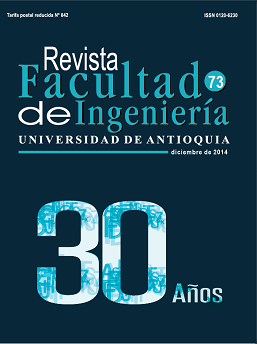Simulation of optical pulse propagation in microstructured waveguides
DOI:
https://doi.org/10.17533/udea.redin.16139Keywords:
finite differences, core, boundary, algorithm, waveguideAbstract
In this paper we study the propagation of optical pulses by the finite differences method in a ridge waveguides structured for applications in optical transmission systems in the region of 1.55 μm. With the transformation of Maxwell’s equations its discrete formulation, for the system under study, and the appropriate boundary conditions was implemented an algorithm in Matlab that enables to visualize the behavior of the pulse when it propagates in the geometry of the waveguide studied. Variations in simulation were made in the wavelength, width of the core and the refractive index materials with which the results obtained were consistent with those reported in the literature. This study allows proposing an appropriate geometry and materials for making waveguides for applications in optical communications systems.
Downloads
References
K. Yee. “Numerical solution of initial boundary value problem involving maxwell´s equatios in isotropic media”. IEEE Transactions on Antennas and Propagation. Vol. 14. 1966. pp. 302-307. DOI: https://doi.org/10.1109/TAP.1966.1138693
Z. Sacks, D. Kingsland, R. Lee, J. Lee. “A perfectly matched layer anisotropic absorber for use as an absorbing boundary conditions”. SIAM. Vol. 512. 2012. pp. 317-337.
D. Sullivan. Electromagnetic simulation using the FDTD method. 2nd ed. Ed. IEEE Press. New York, USA. 2007. pp. 180-207.
A. Taflove, S. Hagness. Computational electrodynamics the finite-difference time-domain method. 2nd ed. Ed. Springer. 2012. pp. 245-282.
F. Racedo, N. Torres. Teoría electromagnética. 1st ed. Ed. Universidad del Atlántico. Barranquilla, Colombia. 2010. pp. 25-65.
M. López, J. Gaspar, J. Manzanares. “Aplicación del método de diferencias finitas en el dominio del tiempo a la simulación del campo electromagnético usando Matlab”. Revista Mexicana de Física. E 52. 2006. pp. 58-64.
S. Valbuena, F. Racedo. Método de diferencias finitas en electromagnetismo. 1st ed. Ed. EDUCOSTA. Barranquilla, Colombia. 2010. pp. 15-45.
S. Nam, J. Kang, J. Kim, “Direct pattering of polymer optical waveguided using liquid state UV-curable polymer”. Macromolecular Research. Vol. 14. 2006. pp. 114-116. DOI: https://doi.org/10.1007/BF03219077
U. Ascher and L. Petzold. “Computer methods for ordinary differential equations and differential-algebraic equations”. SIAM. Vol. 137. 1998. pp. 121-138. DOI: https://doi.org/10.1137/1.9781611971392
J. Douglas, H. Rachford. “On the numerical solution of heat conduction problems in two and three space variables”. Transactions of the American Mathematical Society. Vol. 82. 1956. pp. 421-439. DOI: https://doi.org/10.1090/S0002-9947-1956-0084194-4
C. Fletcher. Computational techniquess for fluid dynamics. 1st ed. Ed. Springer-Verlag. Berlin, Germany. 1988. pp.125-132.
Downloads
Published
How to Cite
Issue
Section
License
Copyright (c) 2018 Revista Facultad de Ingeniería

This work is licensed under a Creative Commons Attribution-NonCommercial-ShareAlike 4.0 International License.
Revista Facultad de Ingeniería, Universidad de Antioquia is licensed under the Creative Commons Attribution BY-NC-SA 4.0 license. https://creativecommons.org/licenses/by-nc-sa/4.0/deed.en
You are free to:
Share — copy and redistribute the material in any medium or format
Adapt — remix, transform, and build upon the material
Under the following terms:
Attribution — You must give appropriate credit, provide a link to the license, and indicate if changes were made. You may do so in any reasonable manner, but not in any way that suggests the licensor endorses you or your use.
NonCommercial — You may not use the material for commercial purposes.
ShareAlike — If you remix, transform, or build upon the material, you must distribute your contributions under the same license as the original.
The material published in the journal can be distributed, copied and exhibited by third parties if the respective credits are given to the journal. No commercial benefit can be obtained and derivative works must be under the same license terms as the original work.










 Twitter
Twitter